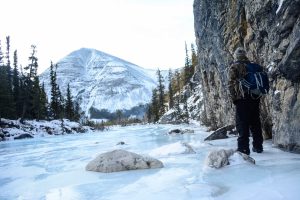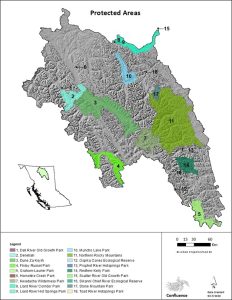Protected Area Management Effectiveness in the Muskwa Kechika
Categories:

Around the world, protected area agencies are challenging the “paper parks” phenomenon – i.e., when new areas are designated as parks but receive little or no resources for implementation. This is in response to growing concern about the effectiveness of protected areas in meeting objectives such as biodiversity conservation and has led to initiatives to examine the global framework called, Protected Areas Management Effectiveness (PAME). PAME is an “assessment of how well protected areas are being managed – primarily the extent to which management is protecting values and achieving goals and objectives”.
PAME evaluations are endorsed by the Convention on Biodiversity (CBD) and the National Advisory Panel tasked to achieve Canada Target 1. The CBD commits signatories like Canada to ensure its protected areas are “effectively and equitably managed”. Similarly, Canada’s Conservation Vision: A report of the National Advisory Panel recommended that PAME be applied to 60 percent of protected areas by 2020 and 100 percent assessed by 2030. Canada’s progress on PAME can be viewed on the Protected Planet website, a site that contains the global database of protected areas and PAME evaluations.
In 2018, BC Parks made a commitment to begin conducting PAME evaluations through the Ministry of Environment and Climate Change Strategy Service Plan starting with a conservation assessment of the Garibaldi Complex. Most recently, BC Parks applied the Protected Area Management Effectiveness (PAME) process to gauge how well the protected areas within the Muskwa-Kechika Management Area (M-KMA) are working to conserve nature, and answer the question, “are we protecting what we said we’d protect?” This blog tells this story.

BC Parks manages the third largest park system in North America, including many remote sites that are geographically dispersed across a range of ecoregions and habitats. The protected areas situated within the Muskwa-Kechika Management Area (M-KMA) are some of the more remote sites in the provincial protected area system.The M-KMA spans 6.4 million hectares of mountainous ecosystems and abundant gravel-bed ecosystems in the Northern Rockies within the traditional territories of the Kaska-Dene First Nations, Treaty 8 First Nations and the Tsay Keh Dene. This large, spatially dispersed area presents unique management challenges when compared with more near urban parks.
Twenty-seven percent of the M-KMA is designated as provincial parks, protected areas or ecological reserves (figure 1). Apart from small portions of the four protected areas that are located adjacent to the Alaska Highway (Northern Rockies, Stone Mountain, Muncho Lake and Liard Hot Springs), the M-KMA protected areas contain mostly undisturbed watersheds, intact predator-prey relationships, and provide remote, wildland experiences.
While this remoteness supports the many protected area values present, it also makes it challenging for staff to visit these sites on a routine basis. As such, there is a limited understanding of the values and impacts that exist in the M-KMA protected areas.
Fortunately, with the support of the BC Parks Licence Plate Program, additional conservation management was initiated in the M-KMA. Surveys of thinhorn (Stone’s) sheep occurred with cooperation from the Ministry of Forests, Lands, Natural Resource Operations and Rural Development in Kwadacha Wilderness Park and Northern Rocky Mountains parks to better inform management of this blue-listed species. In addition, the BC Parks Licence Plate and Living Lab programs have contributed funding to the BC Parks iNaturalist Project which has been steadily increasing our biodiversity data across the provincial park system thanks to citizen scientists and researchers alike.
Finally, BC Parks is developing a strategic management plan for several of the individual parks, protected areas, and ecological reserves within the M-KMA along with a separate plan for Liard River Hot Springs Provincial Park. These plans will complement the recently completed management plans for Redfern-Keily Provincial Park and the Northern Rocky Mountains Provincial Park and Protected Area. These four management plans fulfill a legislated strategic planning commitment of the Muskwa-Kechika Management Area Act and outline the vision and direction for all the M-KMA protected areas. The strategic management plan and the Liard River Hot Springs Park Management Plan will integrate the findings of the PAME evaluation. Management plans are key tools to help determine the appropriate levels of use and development and respond to current and predicted future threats.




